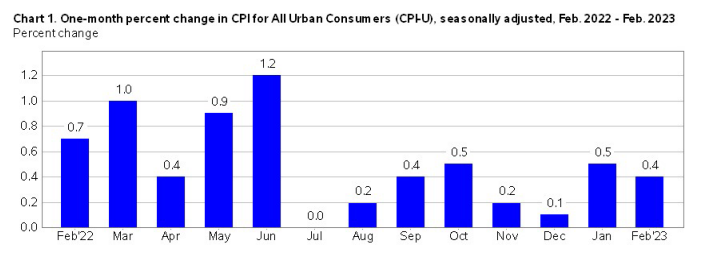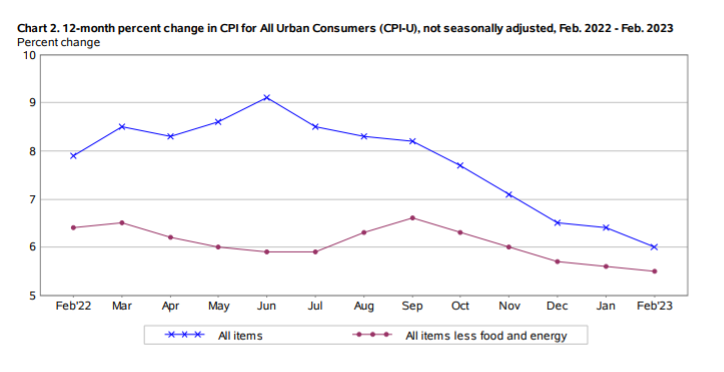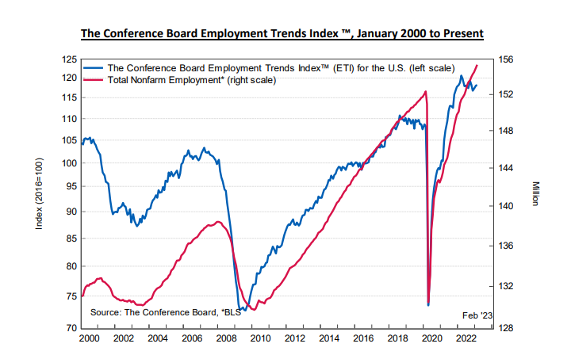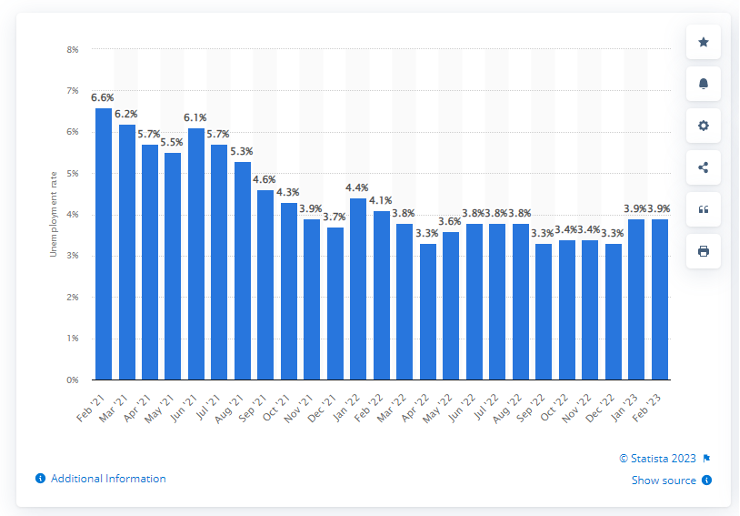KPI — March 2023: State of the Economy

The Consumer Price Index for All Urban Consumers (CPI-U) rose another 0.4% in February on a seasonally adjusted basis, after increasing 0.5% in January, says the U.S. Bureau of Labor Statistics. Over the last 12 months, the all-items index increased 6% before seasonal adjustment – the smallest 12-month increase since September 2021.

Important Takeaways, Courtesy of the U.S. Bureau of Labor Statistics:
- Categories on the rise include shelter, recreation, household furnishings and operations, plus airline fares. The indexes for used cars and trucks and medical care decreased.
- The all items less food and energy index rose 5.5%, while the food and energy indexes increased 9.5% and 5.2%, respectively.

Employment
In February, the number of unemployed persons edged up to 5.9 million with the unemployment rate reaching 3.6%, according to the U.S. Bureau of Labor Statistics. The labor force participation rate is relatively unchanged at 62.5%, with the long-term unemployed (those jobless for 27 weeks or more) accounting for 17.6% of the total unemployed.
Overall job growth climbed, despite the Federal Reserve’s efforts to slow the economy and course-correct inflation from its highest level since the early 1980s. Ironically, a strong jobs report may spell bad news, according to Gus Faucher, PNC Financial Services chief economist.
“It’s much hotter than the economy can run, so this means the Fed is going to have to continue to hike interest rates – and that makes a recession more likely,” he says, predicting the Fed to press forward with a more aggressive half-point rate hike in late-March.
There is healthy disagreement among seasoned economists and business owners as to how much is too much when it comes to the Federal Reserve consistently raising rates to combat inflation.
“The Fed keeps raising rates, yet inflation keeps going in the wrong direction,” says Bernie Marcus, Home Depot co-founder. “It’s not staying where it should be. People are struggling. People can’t pay their bills. They can’t fill their tanks with gas. And if you think that’s a good sign…well, I don’t.”
In addition, Silicon Valley Bank’s (SVB) collapse might be the “tip of the iceberg” for the financial system, says Steve Moore, chief economist at FreedomWorks. “I think it’s important for people to understand how this potential banking crisis happened. It’s not because there aren’t enough bank regulators, rather because of the massive inflation and the trillions and trillions of dollars of borrowing that the federal government has done that has put our financial system in great jeopardy and great peril.”
For Marcus, SVB’s collapse may serve as “a wake-up call.” He points to the current administration touting a strong economy but reaffirms that Americans are facing increasingly tough times.

The Conference Board Employment Trends Index™ (ETI) rose to 118.29 in February, compared to a downwardly revised 118.14 in January 2023.
By Demographic
This month, unemployment rates among the major worker groups: adult women – 3.2%, adult men – 3.3%, teenagers – 11.1%, White – 3.2%, Asian – 3.4%, Hispanic – 5.3% and Black – 5.7%.
Last month, unemployment rates among the major worker groups: adult women – 3.1%, adult men – 3.2%, teenagers – 10.3%, Asian – 2.8%, White – 3.1%, Hispanic – 4.5% and Black – 5.4%.

Monthly unemployment rate in the U.S. from February 2021 to February 2023 (seasonally-adjusted).
By Industry
Total non-farm payroll employment increased by 311,000 in February. According to current data, notable job gains occurred in leisure and hospitality, retail trade, government and health care.
“So far, job growth in 2023 has been strong and the Index (ETI) remaining quite high signals that solid job gains will likely continue over the next months,” says Frank Steemers, senior economist at The Conference Board.
Important Takeaways, Courtesy of the U.S. Bureau of Labor Statistics:
- Employment in leisure and hospitality increased by 105,000 in February. Food services and drinking places added 70,000 jobs, while employment continued to trend up in accommodation (+14,000). Employment in leisure and hospitality is below its pre-pandemic February 2020 level by 410,000, or 2.4%.
- Employment in retail trade increased by 50,000, reflecting a gain in general merchandise retailers (+39,000).
- Employment in professional and business services continued to trend up (+45,000), with a gain of 12,000 in management, scientific and technical consulting services. Employment in professional and business services increased by an average of 35,000 per month over the prior six months.
- Employment in transportation and warehousing decreased 22,000 jobs in February, including 9,000 in truck transportation. Overall, employment in transportation and warehousing is down by 42,000 since October 2022.
Review all employment statistics here.
“While the labor market remains resilient, higher interest rates are expected to negatively impact job growth later in 2023,” Steemers says. “Signs of cooling are already visible in some industries. Job gains have slowed in transportation and warehousing, finance and insurance, and layoffs have already been implemented in the information services sector, which includes tech companies. The recent steep decline in job openings in construction may foreshadow reduced hiring over the next months as higher interest rates reduce demand for new construction projects. However, health care and social assistance and leisure and hospitality continue their rapid pace of hiring.”
Steemers says demand for workers is balancing with labor supply, as participation rates are on the rise during the past few months. Participation for those aged 25 to 54 is back at its pre-pandemic rate of 83.1%. “Nevertheless, labor shortages remain severe and are unlikely to disappear soon,” he says.
KPI — March 2023: Consumer Trends
Key Performance Indicators Report — March 2023



